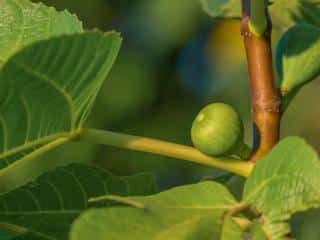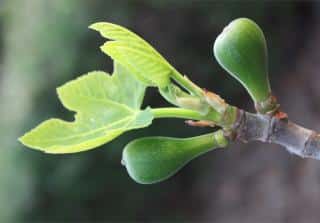

Ficus carica, the common fig tree, produces either green, black or purple figs.
Ficus Carica Facts
Name – Ficus carica
Family – Moraceae (mulberry family)
Type – fruit tree
Height – 16 to 32 feet (5 to 10 m)
Exposure – full sun
Soil – ordinary
Foliage: deciduous
Fruit formation: end-spring → early fall – Harvest: mid-summer → early fall
Fig fruits are appreciated of course for their taste, but connoisseurs know that it helps deal with stress and troublesome digestion.
Ideally, Ficus carica should be planted in fall or in spring for colder climates.
Bare-rooted Ficus carica should only be purchased and planted in fall: mid-november to mid-december is best, if it doesn’t freeze.
 Ficus carica requires cool, well-drained soil.
Ficus carica requires cool, well-drained soil.Although Ficus carica can produce beautiful figs if left unpruned, there are good reasons to prune anyway.
Pruning your Ficus carica will speed their growth and increase fig productivity.
It is fairly common for figs not to ripen on some Ficus carica.
Fruits appear after flowering, grow to about an inch (a couple centimeters) across, then fall off before having ripened completely.
The cause for this is often quite straightforward, and can be related to one or more of the following factors:
Ficus carica is one of those fruit trees that require a long root development phase before fruits appear.
There isn’t much to do about it: you must simply wait until roots have developed enough.

Fig trees are the only European native member of the genus, and they are considered symbols of the Mediterranean and of Provence in particular, together with olive trees.
Fig trees are also very appealing fruit trees, famous for the delicate and consistent taste of their fruits which are associated to numerous health benefits.
These are easygoing trees, hardy and versatile in that they adapt to most types of soil. Ficus carica is hardy to 5°F (-15°C), and sometimes even colder if the cold bursts are short.
Figs are produced over an extended period of time thanks to continuous flowering, and productivity can top 220 pounds (100 kg) for a single tree!
Did you know that the sap or latex of Ficus carica is very similar to that of certain types of rubber trees?
Ficus carica is very easy to layer, choose a nice branch and prepare your own layering!